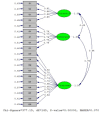Psychometric properties of the educational leadership scale for nursing students
- PMID: 40329295
- PMCID: PMC12057159
- DOI: 10.1186/s12909-025-07269-6
Psychometric properties of the educational leadership scale for nursing students
Abstract
Background: Educational leadership plays a crucial role in the development of nursing students, significantly enhancing their clinical skills and preparing them to lead advancements in healthcare. This comprehensive educational approach ensures that nursing students are well-equipped to address contemporary healthcare challenges effectively.
Aim: This study aimed to translate the Educational Leadership Scale for Nursing Students into Persian and evaluate its psychometric properties among Iranian nursing students.
Methods: This cross-sectional methodological study was conducted in two phases: translation and cultural adaptation, followed by psychometric evaluation. After obtaining permission from the original scale developer, the scale was translated into Persian using the Pilot and Yang model. Face and content validity were assessed both qualitatively and quantitatively. Construct validity was evaluated through exploratory factor analysis (EFA) and confirmatory factor analysis (CFA). A convenience sample of 469 nursing students from nursing faculties in Kermanshah Province, Iran, completed the questionnaire. Internal consistency was evaluated using Cronbach's alpha and McDonald's omega coefficients. Test-retest reliability was assessed using the intraclass correlation coefficient (ICC) in a subsample of 47 nursing students.
Results: Exploratory and confirmatory factor analyses confirmed the three-factor structure of the Persian version of the instrument, with 19 items accounting for 63.80% of the total variance. The model fit was excellent, as shown by the CFI, GFI, TLI, RMSEA, and SRMR values. The scale demonstrated acceptable internal consistency reliability, with Cronbach's alpha at 0.924 and McDonald's omega at 0.923. The ICC for the total score was 0.924 (95% CI: 0.910-0.936).
Conclusion: The results of the present study indicate that the Persian version of the Educational Leadership Scale for Nursing Students possesses acceptable psychometric properties. The results of face, content, and construct validity, along with reliability indices (including internal consistency and test-retest reliability), indicate that this instrument is an effective tool for evaluating educational leadership characteristics among Iranian nursing students. However, to further confirm the validity and reliability of this scale, future studies with larger and more diverse samples of nursing students, including those in clinical settings, are recommended. Furthermore, examining the criterion validity and discriminant validity of this instrument could contribute to a better understanding of its psychometric characteristics.
Keywords: Educational leadership; Nursing student; Psychometric properties; Reliability; Validity.
© 2025. The Author(s).
Conflict of interest statement
Declarations. Ethics approval and consent to participate: This research study received ethical approval from the Ethics Committee of Kermanshah University of Medical Sciences (Ethics code: IR.KUMS.REC.1402.257). Written permission was obtained from the scale's developers for its use. All participants provided written informed consent before participation. The study was conducted in accordance with the principles outlined in the Declaration of Helsinki. All research procedures adhered to relevant guidelines and regulations. Consent for publication: Not applicable. Competing interests: The authors declare no competing interests.
Figures
Similar articles
-
Psychometric properties of the Persian version of the training needs assessment for critical care nurses.BMC Med Educ. 2025 Aug 7;25(1):1149. doi: 10.1186/s12909-025-07657-y. BMC Med Educ. 2025. PMID: 40775627 Free PMC article.
-
Cultural adaptation and psychometric evaluation of the Persian version of the motivation for nursing student scale (MNSS).BMC Med Educ. 2024 Oct 10;24(1):1117. doi: 10.1186/s12909-024-06101-x. BMC Med Educ. 2024. PMID: 39390492 Free PMC article.
-
Assessment of the validity and reliability of the nurses' professional values scale-revised in Persian version among nursing students.BMC Med Educ. 2025 Jan 25;25(1):125. doi: 10.1186/s12909-025-06677-y. BMC Med Educ. 2025. PMID: 39863885 Free PMC article.
-
Integral leadership in nursing: Development and psychometric validation of a Korean version of the Integral Nursing Leadership Scale.Int J Nurs Stud. 2024 Apr;152:104697. doi: 10.1016/j.ijnurstu.2024.104697. Epub 2024 Jan 15. Int J Nurs Stud. 2024. PMID: 38295669 Review.
-
A new perspective and assessment measure for common dissociative experiences: 'Felt Sense of Anomaly'.PLoS One. 2021 Feb 24;16(2):e0247037. doi: 10.1371/journal.pone.0247037. eCollection 2021. PLoS One. 2021. PMID: 33626089 Free PMC article.
Cited by
-
Designing and psychometric evaluation of the nursing instructors clinical leadership style scale (CLSS): a sequential exploratory mixed-methods design.BMC Nurs. 2025 Aug 7;24(1):1040. doi: 10.1186/s12912-025-03694-6. BMC Nurs. 2025. PMID: 40775772 Free PMC article.
References
-
- Reime MH, Bell K, Albrigtsen B, Beisland EG. Baccalaureate nursing students’ reflections on professional development within the nursing leadership role when participating in student-run teams: a qualitative content analysis of student’s reflection notes. SAGE Open Nursing. 2022;8: 23779608221130604. - PMC - PubMed
-
- Nowell L, Davidson S, Gospodinov J, Laing C, Shajani Z, Dewell S, et al. Evaluating fundamental care knowledge to inform educational leadership. J Adv Nurs. 2023;79(3):1174–88. - PubMed
MeSH terms
LinkOut - more resources
Full Text Sources
Miscellaneous


